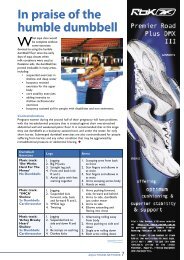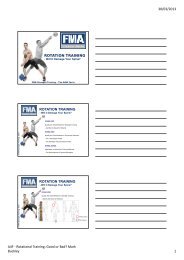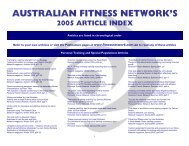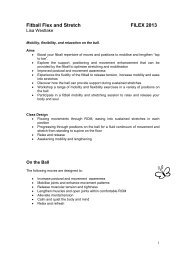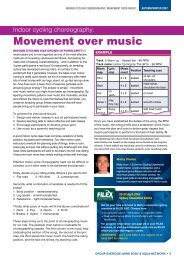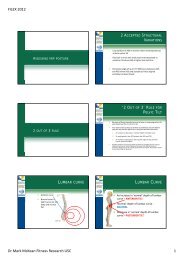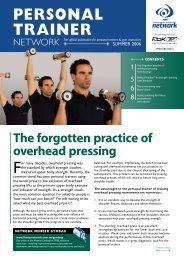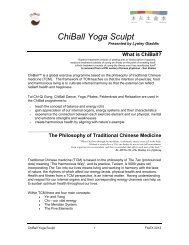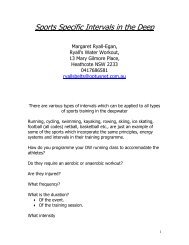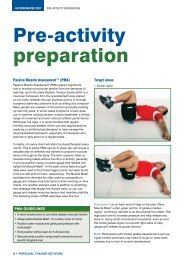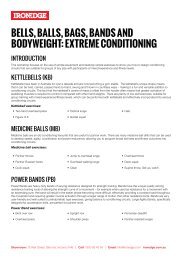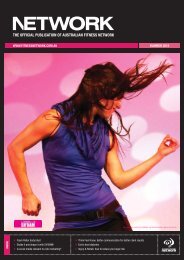CD - Australian Fitness Network
CD - Australian Fitness Network
CD - Australian Fitness Network
You also want an ePaper? Increase the reach of your titles
YUMPU automatically turns print PDFs into web optimized ePapers that Google loves.
AQUA<br />
OSTEO-FIT: BONE-CONSCIOUS AQUATIC EXERCISE<br />
AQUATIC EXERCISE GOALS AND GUIDELINES FOR<br />
PEOPLE WITH OSTEOPENIA OR OSTEOPOROSIS<br />
• Regular exercise, most days of the week, for 30 to 45<br />
minutes per session, targeting all fi tness components<br />
possible (cardiovascular endurance, strength, endurance,<br />
fl exibility). A well-rounded program will include activities<br />
like walking, pool exercise, and the weight room.<br />
• Exercises to build muscle mass – especially strength of the<br />
core and lower extremities.<br />
• Exercises to strengthen postural stabilisers, especially<br />
spinal extensors.<br />
• Activities and challenges to improve balance and fall<br />
recovery.<br />
• Avoid: loaded spinal fl exion (activities like rowing,<br />
crunches, lifting heavy loads), high impact exercises, and<br />
activities that might result in falling.<br />
IDEAS FOR THE POOL<br />
Naturally, you should consider the age, strength, and health of<br />
your clients when trying more diffi cult exercises.<br />
1. Be sure your pool deck is free of trip hazards, and insist that<br />
clients wear appropriate footwear.<br />
2. Be the posture police! People will strengthen postural<br />
stabilisers by maintaining a long, strong spine and stable,<br />
neutral pelvis throughout all movements.<br />
3. Slow your music and movement to allow people time to<br />
stabilise properly.<br />
4. Anchor! Take impact out of your class. Although impact<br />
helps build bone, it can be painful for joints, and may not<br />
be appropriately controlled in the pool. Level II, III, and<br />
grounded movement promote increased core activation<br />
and training.<br />
5. Avoid loaded spinal fl exion: tucks, spinal twisting or lateral<br />
fl exion loaded with resistance such as a noodle or fl utter<br />
board can be risky. Often, osteoporosis isn’t diagnosed<br />
until a fracture occurs.<br />
6. Train the core by maintaining perfect posture during wellcontrolled<br />
movements of the arms and legs. This provides<br />
functional, safe core conditioning.<br />
7. Use a variety of pool depths, if possible. Shallow water<br />
walking loads bones more; deep water vertical stabilisation<br />
is excellent core and balance training.<br />
8. Incorporate balance challenges: if necessary, start with<br />
the support of a pool wall or trainer. Teach fall recovery<br />
before escalating challenges. As mastery is achieved,<br />
increase stability challenges by altering base of support<br />
(narrow versus wide), standing surface (pool fl oor versus<br />
an unstable object), proprioception (close the eyes, turn<br />
the head away from direction of travel) and multi-task – do<br />
activities to challenge balance during mental distraction.<br />
Perform all examples with perfect posture:<br />
a. Weight shifting foot to foot – progress to lifting the<br />
trailing foot.<br />
b. Single leg stance, ‘tight-rope’ (tandem stance) balance<br />
or walk, with postural perturbations such as single arm<br />
circles.<br />
c. Single leg, feet together, or tandem stance – reach out<br />
to the point of loss of balance, and initiate fall recovery.<br />
62 NETWORK WINTER 2010 www.fitnessnetwork.com.au<br />
d. Add attention challenges while maintaining posture<br />
and balance – look away from where you are stepping;<br />
transfer a small ball from hand to hand while walking or<br />
holding a stance.<br />
e. Stand on unstable surfaces, such as a noodle under<br />
one or both feet, in contact with the fl oor, or balance<br />
suspended vertically in deep water (wearing a fl otation<br />
belt) while you do any of the following:<br />
• Toss a small ball between partners.<br />
• Move across the pool with small hops (shallow) or<br />
arm propulsion (deep).<br />
• Change directions of movement unpredictably<br />
(laterally, diagonally).<br />
• Keep the body straight and still while you move<br />
only one arm vigorously.<br />
• Partner tug-of-war using a towel or one or two<br />
noodles.<br />
As confi dence and strength improve, try the above<br />
activities with eyes closed, while counting, singing or saying<br />
the alphabet backwards, turning the head away from the<br />
direction of attention.<br />
Reprinted with permission from the Aquatic Exercise Association,<br />
www.aeawave.com<br />
References and Resources<br />
Ay, A., Yurtkuran, M., Infl uence of aquatic and weightbearing<br />
exercises on quantitative ultrasound variables in<br />
postmenopausal women. Am J Phys Med Rehabil. 2005 Jan;<br />
84(1):52-61.<br />
Colado, J.C., Travis Triplett, N., Tella, V., Saucedo, P., Abellán,<br />
J., Effects of aquatic resistance training on health and fi tness in<br />
postmenopausal women, Eur J Appl Physiol (2009) 106:113–122<br />
Cosca, D., , Aquatic exercise is a great activity at any age, U C<br />
Davis Health System, www.ucdmc.ucdavis.edu<br />
Melzer, I., et al, A water-based training program that include<br />
perturbation exercises to improve stepping responses in older<br />
adults: study protocol for a randomized controlled cross-over<br />
trial, BMC Geriatrics 2008, 8:19<br />
NIH Consensus Dev. Panel. “Osteoporosis Prevention,<br />
Diagnosis, and Therapy.” JAMA 285 286 (2001): 785-795.<br />
National Center for Biotechnology Information. National Library<br />
of Medicine. 18 Oct. 2008 .<br />
‘Osteoporosis.’ MedlinePlus. 10 May. 2008. National Library<br />
of Medicine. 23 Dec. 2008 . “Osteoporosis: Symptoms and Remedies.”<br />
Johns Hopkins Medicine. 2008. 23 Dec. 2008.<br />
Slovik, David M., and Jonas Sokolof. ‘Osteoporosis.’ Frontera:<br />
Essentials of Physical Medicine and Rehabilitation. Eds. Walter<br />
R. Frontera, et al. 2nd ed. Philadelphia: Saunders, Elsevier,<br />
2008.<br />
Wallace, B. A., and R. G. Cumming. Systematic Review of<br />
Randomized Trials of the Effect of Exercise on Bone Mass in<br />
Pre- and Postmenopausal Women. Calcifi ed Tissue International<br />
67 1 (2000): 10-18. National Center for Biotechnology<br />
Information. National Library of Medicine. 18 Oct. 2008 .<br />
Weppner, Dennis M., and Ruben Alvero. ‘Osteoporosis.’ Ferri’s<br />
Clinical Advisor: Instant Diagnosis and Treatment. Ed. Fred Ferri.<br />
Philadelphia: Mosby Elsevier, 2009.<br />
Woollacott, M., Shumway-Cook, A., Attention and the control of<br />
posture and gait: a review of an emerging area of research, Gait<br />
and Posture 16 (2002) 1 – 14, www.elsevier.com/locate/gaitpost<br />
O



